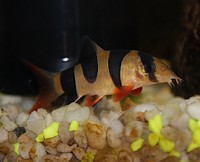
| Species | Clown Loach |
|---|---|
| Latin Name | Chromobotia Macracanthus |
| Family | botiinae |
| Origin | Asia |
| Length | 20 - 25 cm |
| Temperature | 24 - 30°C |
| Water Hardness | soft - medium hard |
| pH | 5.0 - 7.0 |
| Aquarium Size | 300 L |
| Food | live, frozen, dry, plant |
This fish lives in rivers, canals, tributaries, floodplains, and wetlands with dark waters in Indonesia (Borneo and Sumatra).
Colour of the body is yellow-orange with three transverse, thick, and dark bands. The first stripe intersects the eye, the third stripe intersects the dorsal and anal fins. Size and color of this species depend on the their habitat. Differences are in the pelvic and the caudal fins colour. There is also 7 variants of this species which differ in shape and the number of the stripes/spots. There are:


It has 4 pairs of barbel on the chin and defensive spines under eyes fish uses them in an emergency. Females are a bit larger and thicker in the ventral parts.
This is medium aggressive, a bit territorial and shoal species. Fish prefers to live in a group of 5-6 minimum when all aggressive behaviour stays within the group. Fish forms a social hierarchy with dominant male in the group. Botia is very inquisitive, active, and intelligent fish. It can get into every available hole, it can rest or sleep in a funny way lying on the side, floating at an angle - head down or head up, or balancing in plants or decorative elements on the pelvic and caudal fins. These fish often gives a specific sounds during feeding, they are the bottom feeding species. They dig in the substrate, they nibble long, flowing fish fins so you should not keep them with betta fish, guppies etc. You should't keep them with smaller fish. Botias like company of other botias, rainbowfish, fish of the genus Epalzeorhynchos or Catfish etc.
Botia may be kept in a general or biotope aquariums (e. g. "dark water"). The tank should include soft substrate (sand or fine gravel), decorative elements with soft and rounded edges (rocks, stones, pots, roots, pvc or ceramic pipes, coconut shells), hard plants (anubias, java moss, microsorum pteropus), dimmed light (floating plants or floating pieces of wood). Aquarium should be covered because this fish may jump out of the aquarium. All holes and passes should be big enough so fish does not get stuck. These species like good-quality of water. They may be only put in to the chemically stable water, with established nitrogen cycle. Fish are sensitive to accumulated organic matter (arising nitrates and nitrites) so the partial water changes should be done regularly. The aquarium should be equipped with an effective filtration system. Water should be oxygen-rich and with medium flow. Fish are very sensitive to a parasitic infections and temperature fluctuations.
This is an oviparous species. It reproduction is random and occasional in the aquarium. Fish breed in the rainy season when temperature of water and pH is reduced, so you can stimulate fish to spawn through bigger partial water changes on few degrees cooler water and by water pH reduction by adding leaves of oak, beech, indian almond, cones of alder. Fish usually breed in the group of over a dozen. They lay roe in narrow hiding-place like rock cracks, pvc pipe etc.).